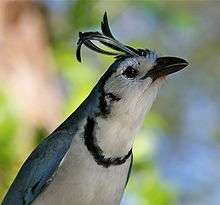White-throated magpie-jay
| White-throated magpie-jay | |
|---|---|
 | |
| In Costa Rica | |
| Scientific classification | |
| Kingdom: | Animalia |
| Phylum: | Chordata |
| Class: | Aves |
| Order: | Passeriformes |
| Family: | Corvidae |
| Genus: | Calocitta |
| Species: | C. formosa |
| Binomial name | |
| Calocitta formosa Swainson, 1827 | |
The white-throated magpie-jay (Calocitta formosa) is a large Central American species of magpie-jay. It ranges in Pacific-slope thorn forest from Jalisco, Mexico to Guanacaste, Costa Rica. Magpie-jays are noisy, gregarious birds, often traveling in easy-to-find flocks, mobbing their observers.
Taxonomy
The white-throated magpie-jay hybridizes in Jalisco with the black-throated magpie-jay (C. colliei), with which it forms a superspecies. There are three recognised subspecies, the nominate race, which is only found in southern Mexico; C. f. azurea, which is found in south eastern Mexico and western Guatemala, and C. f. pompata, which runs from south eastern Mexico to Costa Rica.[2]
Description

The white-throated magpie-jay is between 43 to 56 cm (17–22 in) in length and weighs 205 to 213 g (7.2–7.5 oz). The species has a particularly long tail and a slightly curved crest of feathers on the head. The crest is black in the nominate race, but has blue or white margins on the other two subspecies. The nominate race has a white face with a black crown and margin to the face, forming a narrow band around the throat, as well as a small drop below the eye. The black is less extensive in the other subspecies. The breast, belly and underside of the rump are white, and the wings, mantle and tail are blue (with whitish margins on the tail). The legs and eye are black, and the bill is grey. The plumage of the females is mostly as that of the male but duller on the top, with a narrower band across the chest, and the tail is shorter.[2]
Habitat
The white-throated magpie-jay is associated with a wide range of habitats from arid environments to semi-humid woodlands, from sea-level up to 1,250 m (4,100 ft), although only occasionally higher than 800 m (2,600 ft). It occurs rarely in columnar cacti forest, but is common in thorn forest, gallery forest, deciduous woodland, forest edges and cultivated areas like coffee plantations. The species does not undertake any migratory movements, although males disperse away from their natal territories a few years after fledging. It is a common species across its range, and is not considered threatened by human activities.[2]
.jpg)
Behaviour
White-throated magpie-jays are omnivorous, consuming a wide range of animal and plant matter. Items included in the diet include invertebrates such as insects and caterpillars, frogs, lizards, eggs and nestlings of other birds, seeds, fruits, grain, and nectar from Balsa blossoms.[2] Younger birds take several years to acquire the full range of foraging skills of their parents.[3]
References
- ↑ BirdLife International (2012). "Calocitta formosa". IUCN Red List of Threatened Species. Version 2013.2. International Union for Conservation of Nature. Retrieved 26 November 2013.
- 1 2 3 4 Marzluff, John (2009). "Family Corvidae (Crows)". In del Hoyo, Josep; Elliott, Andrew; Christie, David. Handbook of the Birds of the World. Volume 14: Bush-shrikes to Old World Sparrows. Barcelona: Lynx Edicions. p. 587. ISBN 978-84-96553-50-7.
- ↑ Langen, Tom (1996). "Skill acquisition and the timing of natal dispersal in the white-throated magpie-jay, Calocitta formosa" (PDF). Animal Behaviour. 51 (3): 575–588. doi:10.1006/anbe.1996.0061.
External links
| Wikimedia Commons has media related to Calocitta formosa. |
| Wikispecies has information related to: Calocitta formosa |
- BirdLife species factsheet for Calocitta formosa
- "White-throated magpie-jay media". Internet Bird Collection.
- White-throated magpie-jay photo gallery at VIREO (Drexel University)
- White-throated magpie-jay species account at NeotropicalBirds (Cornell University)
